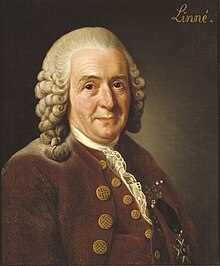Carl Linnaeus
| Carl Linnaeus (Carl von Linné) | |
|---|---|

|
|
| Born |
23 May 1707 Råshult, Stenbrohult parish (now within Älmhult Municipality), Sweden |
| Died | 10 January 1778 (aged 70) Hammarby (estate), Danmark parish (outside Uppsala), Sweden |
| Resting place |
Uppsala Cathedral 59°51′29″N 17°38′00″E / 59.85806°N 17.63333°E |
| Residence | Sweden |
| Nationality | Swedish |
| Fields |
Botany Biology Zoology |
| Institutions | Uppsala University |
| Alma mater |
Lund University Uppsala University University of Harderwijk |
| Thesis | Dissertatio medica inauguralis in qua exhibetur hypothesis nova de febrium intermittentium causa (1735) |
| Notable students | Peter Ascanius |
| Known for |
Binomial nomenclature Scientific classification Taxonomy |
| Author abbrev. (botany) | L. |
| Author abbrev. (zoology) | Linnaeus |
| Spouse | Sara Elisabeth Moraea |
| Children | 7 |
| Signature | |
Carl Linnaeus (/lɪˈniːəs, lɪˈneɪəs/; 23 May 1707 – 10 January 1778), also known after his ennoblement as Carl von Linné (Swedish pronunciation: [ˈkɑːɭ ˈfɔnː lɪˈneː]), was a Swedish botanist, physician, and zoologist, who formalised the modern system of naming organisms called binomial nomenclature. He is known by the epithet "father of modern taxonomy". Many of his writings were in Latin, and his name is rendered in Latin as Carolus Linnæus (after 1761 Carolus a Linné).
Linnaeus was born in the countryside of Småland, in southern Sweden. He received most of his higher education at Uppsala University, and began giving lectures in botany there in 1730. He lived abroad between 1735 and 1738, where he studied and also published a first edition of his Systema Naturae in the Netherlands. He then returned to Sweden, where he became professor of medicine and botany at Uppsala. In the 1740s, he was sent on several journeys through Sweden to find and classify plants and animals. In the 1750s and 1760s, he continued to collect and classify animals, plants, and minerals, and published several volumes. At the time of his death, he was one of the most acclaimed scientists in Europe.
...
Wikipedia
